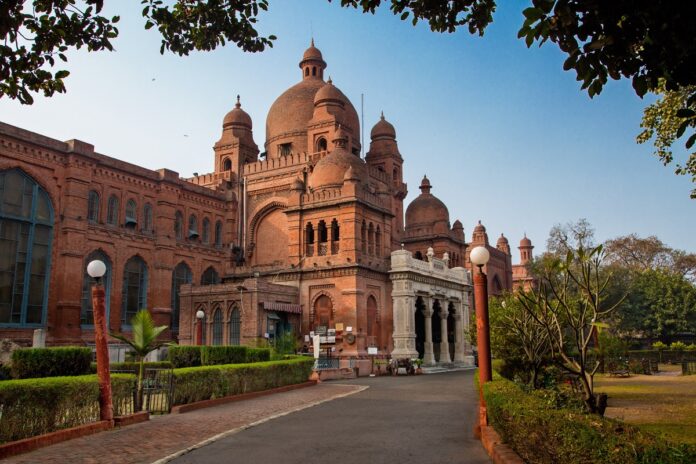Introduction
I visited Lahore for the first time eighty years ago but the entire picture of those days is as clear in my eyes as daylight. After retirement as a Risaldar my maternal grandfather had built a house outside SHERANWALA gate close to the MAULVI FEROZE DIN KA CHAPA KHANA (Press). I was told by my elders that during the period of Maharaja RANJIT SINGH (the ruler of Punjab) two domesticated lions were kept in a cage outside the gate to terrify the people.
A few hundred yards in the east of the Lahore Fort was located MASTI gate, the name is the corruption of MASJIDI pertaining to a mosque of MARIAM MAKANI, mother of AKBAR, located in its immediate vicinity. I found the city surrounded by gardens that consisted of multifarious types of trees and people used to walk through the gardens enjoying the fragrance of the flowers and scented air.
One morning, I alongwith my cousins went around the fort wall and upon reaching the stairs found some musicians sitting there; some were singing while some were playing musical instruments with tabla and sitar being most prominent. Frequently they received applause from the people who gathered there. I learnt that this was the practice (RIAZ) time of musicians living in the vicinity.
On Sunday my maternal uncle took me to the MINTO Park (near Iqbal Park) which was filled with people, many were flying kites. During the match some kites used to disappear in the horizon but could not be pulled down and perforce the strong thread that was coated with glass powder mixed in flour glue, was cut and was left for the looters present with long bamboo sticks crowned with thorny branches of bushes. Even non-Muslim women were seen enjoying such kite flying matches.
I remember I used to love breakfast with KULCHA, two spoonful of HALWA and a glass of LASSI – costing only two Paisas in those days!
A Haveli with a big compound was situated close to the house of my maternal grandfather. One day a lot of people were seen gathering outside the Haveli and the beating of big sized drums was heard. I was told that wrestling bouts were about to be held and the main bout would be between BULLARD (a Hindu wrestler) and GONGA (deaf and dumb) Pehlwan. Accompanied by my uncle, I entered the Haveli after buying tickets and after a few lightweight and middleweight bouts the main bout commenced. With minutes GONGA threw his opponent on the ground and sat on his chest for a minute; he was declared the winner. The area then resounded with shouts, drum beating and slogans in favour of GONGA. My uncle pointed out to me the wrestler IMAM BUX – who was known as Rustam-e-Hind (younger brother of GAMA, Rustam-e-Zaman) sitting near the judge of the bout. My uncle then took me down and requested IMAM BUX and GONGA to shake hands with me, which they did. This was a most thrilling experience for me and I often feel the strong grip of these two great wrestlers.
One day my maternal grandfather (who was about 95 years old) was polishing his medals and oiling his pistol and 12 bore gun and I and my cousins sat close to him. He disclosed that he had taken part in the 2nd Afghan War (1879-81) and told us about his experience of fighting. He had many skirmishes with the Afghans alongwith his comrade-in-arms. He said eventually the British Indian army was successful.
From the stairs of the fort I saw the lofty minarets of the BADSHAHI MASJID. My elders told me that during my next visit to Lahore I would be allowed to see many historical buildings because presently I was too young to climb and cover long distances.
My father came to Lahore to collect his family members and took me to ANARKALI bazaar where 90% of shops at that time belonged to non-Muslims. As I had passed 5 standard with distinction, he bought me an air gun from the shop of Sheikh INAYAT ULLAH that was a big shop of a Muslim.
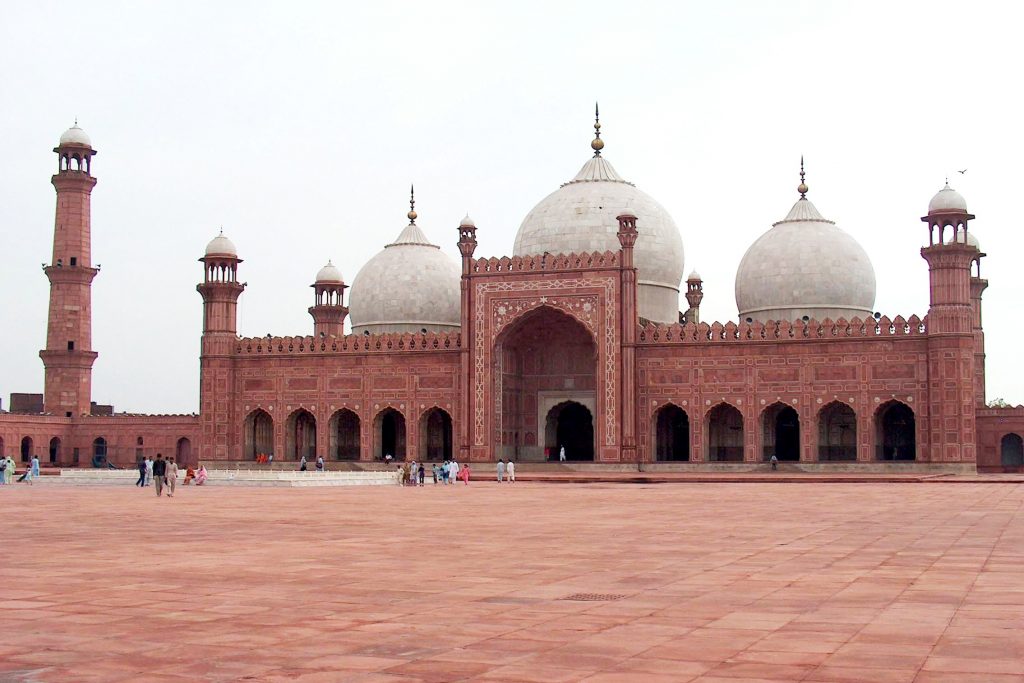
Second Visit to Lahore
After passing 8th class I went to LAHORE to pass a few weeks of my summer vacation. My maternal grandfather had died two years earlier. I was excited on this visit as I had been promised that I would be able to visit some historical places. My elder cousins were my guide.
Some distance away to the west of Lahore Fort was located the Badshahi Masjid that was built for Emperor AURANGZEB ALAMGIR by his foster brother FIDAI KHAN in 1783 AD. The most imposing and beautiful building of Lahore, the façade of the archway was 66 feet 10 inches long (according to one history book) and 527 feet long while the east and west sides were paved with solid bricks. The floor was found damaged at places and in the center was a pond full of water for ablution. The roof of the Masjid was surmounted by three cupolas (domes) of white marble crowned with pinnacles of brass. In each corner there was a minaret of red sandstone towering above every object, the height of each minaret was 143 feet and 6 inches. All the four minarets had lost one storey, surmounted with cupola which was shaken by an earthquake in 1840 and removed. I climbed the minaret on the left side, stood on top and looked towards the tomb of JAHANGIR. I could only see three minarets of the tomb because one was hidden behind the first. This was not a coincidence but a feat of engineering. From the top the plying tongas (there were no cars or buses) looked like moving matchboxes. Under the domes could be seen the principal hall with several arched entrances.
Some relics of the Holy Prophet (PBUH), Hazrat Ali, Hazrat Fatima, Hazrat Hussain and Ghaus-e-Azam were kept in glass cases in the upper storey of the splendid archway.
Close to the Badshahi Masjid I saw the SAMDHI of Maharaja Ranjit Singh and was infuriated as to why the Sikh ruler was allowed to be cremated there. I was told, and subsequently read, that the Sikhs were stubborn and impervious, they had no respect for the religious places (mosques, tomb, shrines, etc) of the Muslims. In fact most of the mosques, including the Badshahi, were used as stables, magazines (for arms and ammunition) and the troops drill square by European instructors. The Sikh Sirdars and Maharaja Ranjit Singh had indulged in ruthless vandalism and had stripped precious stones, marble slabs of white, red and black from mosques, tombs, gardens, palaces and forts for their palaces, samadhis and havelis. Even the Golden Temple of AMRITSAR was supplied with marble slabs, precious stones and even bricks avariciously and mercilessly pulled out from the Muslim buildings.
Who is the Founder of Lahore?
According to historians, Lahore was founded by LOR or LOV, one of the sons of RAMA, the hero of RAMAYAN the religious book of the Hindus. It is also recorded in history books that RAMA’s other son KASH had founded the town of KASUR. There have been many rulers of Lahore, the RAJPUTS, the Muslims and Sikhs. The Muslims remained the rulers for about 800 years but in this article I will highlight the Sikh domination of Lahore.
How Sikhs became the Masters of Lahore
During the 6th invasion of AHMAD SHAH ABDALI of India (1762) the Sikhs raised a large force and opposed in the battle of KOTRAHIRA, on the south bank of the river SUTLEJ in which the Sikhs were utterly routed. The disaster is called by the Sikhs as ‘bloody carnage’ because 25000 to 30000 of them were killed in the battle.
During 1761 the Great Battle of PANIPAT (3rd) was fought between the Mahrattas and AHMAD SHAH ABDALI. The Mahrattas were superior in numbers (infantry, cavalry, guns and war elephants) but ABDALI with his strategy and bold tactics was able to surround the Mahratta camp, block the routes of supplies and reinforcements. However the Sikhs were able to delivery much needed supplies by longer routes, but that was enough for only a few days. After the decisive defeat of the Mahrattas ABDALI returned to KABUL and in his absence the Sikhs rushed down again in the plains of Punjab. They sacked KASO and under GUJAR SINGH, LAHNA SINGH and SOBBA SINGH occupied LAHORE and divided it in three divisions. The Sikhs with their martial enthusiasm were ruling with iron hand and had managed to crush all opposition.
During 1797 SHAH ZAMAN, the grandson of AHMAD SHAH ABDALI invaded Lahore at the head of a strong force. His advance also alarmed the English capital (CALCUTTA), troops were alerted and strength of the natives was increased with recruitment. Some historians have even mentioned that ships were kept ready for evacuation. But SHAH ZAMAN retired to KABUL to crush a rebellion. During 1798 he again appeared in Lahore but after collecting large sums from the locals he returned to challenge the Persians who had risen against him. But before leaving Lahore SHAH ZAMAN granted the imperial city of Lahore to RANJIT SINGH son of MAHA SINGH in return for the services rendered by him, especially for the recovery of and dispatch to KABUL of the eight out of 12 guns which had sunk in the river JHELUM. For implementing his rule RANJIT SINGH was supported by some influential personalities of LAHORE including Muslims. He had declared himself MAHARAJA and assumed the title of SIRKAR. In 1803 he occupied AMRITSAR, in 1806 he crossed the Sutlej and took LUDHIANA and in 1807 conquered KASUR. In 1809 RANJIT SINGH entered into a treaty with the British Government and agreed not to cross the Sutlej River. In 1807 he captured KANGRA and after a clash with the AFGHAN forces he took possession of ATTOCK. In 1813-14 with cheat, threat and malicious deception he wrested the world famous KOH-I-NUR diamond from SHAH SHUJA ex-King of KABUL. For the interest of our learned readers the following passage is reproduced from a history book published in 1890.
In March 1813, Shah Shuja came to Lahore with his principal wife, Wafa Begum. Half-guest and half-prisoner of Ranjit Singh, that greedy monarch, with whom, in advanced years, the hoarding of treasures had become almost a passion compelled him to surrender the Koh-e-Nur on a promise to pay three lakhs of rupees in each and grant of a jagir of Rs. 50000 per annum with a promise of aid in recovering Cabul. The touching incident which led to the surrender of the diamond by Shah Shuja to the Sikh ruler, is thus described by persons who were eye-witnesses to the scene:-
On the 1st of June 1813, the Maharaja sent Faqir Aziz-ud-din, Bhai Gur Baksh Singh and Jamadar Khushal Singh to Shah Shuja to demand the diamond. The Shah returned for answer that the Maharaja should come to take the diamond himself. Ranjit Singh, on hearing this, cheerfully mounted his horse and escorted by troops on the right and left, and taking with him a sum of Rs. 1000 in cash, repaired to Mubarak Haveli, the Shah’s residence. His Afghan Majesty received the Maharaja with great dignity. Both being then seated, a solemn pause ensued which lasted nearly an hour. At length, the patience of Ranjit Singh being exhausted, he whispered in the ear of his attendants who reminded the Shah of the object of the meeting. The Shah returned no answer but made a signal with his eye to one of his servants who retired and after a while brought in small roll which he placed on the carpet at an equal distance between the two chiefs. Mutual friendship was declared and an exchange of turbans took place as a token of perpetual amity between the two. The roll being then unfolded RANJIT recognized the diamond and asked the SHAH its price. The vexed Shah replied “Its price is LATHI (heavy stick). My forefathers obtained it by this means, you have obtained it from me by many blows; after you a stronger power will appear and deprive you of it using similar means.”
On the conquest of the Punjab by the British and the abdication of Maharaja DALIP SINGH in 1849, the diamond was formally made over to the Board of Administration; subsequently on 3rd July 1850 it was formally presented to Her Majesty the Queen VICTORIA.
SUNEHRI Masjid is a beautiful and elegant small building built in 1753. The Sikhs had plastered the floor with cow dung and placed the GRINTH in the centre. The Muslims approached the Maharaja for its restoration but it was refused. But GULLU mashki- water carrier was in high favour with Maharani JINDAN, the queen of RANJIT SINGH and through his efforts the Masjid was restored.
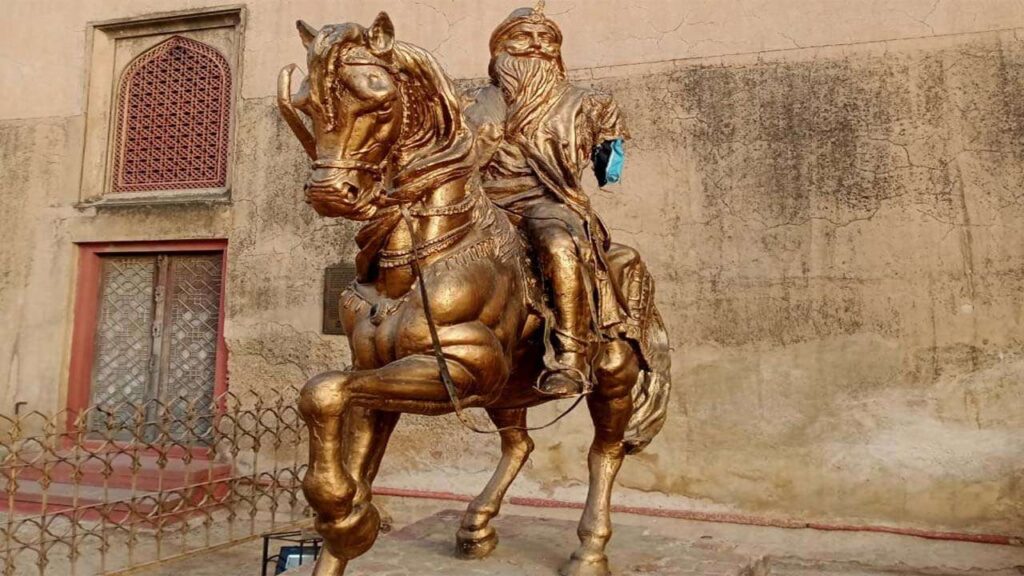
Successors of RANJIT SINGH
After the death of RANJIT SINGH on 27th June 1839 at the age of 57, he left a kingdom which extended from the confines of Tibet to the SULEMAN Mountain and from beyond the INDUS to the extreme limits of MULTAN. He had created an army of 80000 of all arms in a high state of discipline supported by about 300 guns of different caliber.
He was succeeded by his eldest son KHARAK SINGH a mentally weak person who was in the habit of taking heavy doses of opium. The affairs of the state were run by his clever son NAUNEHAL SINGH. It is said NAUNEHAL SINGH on coming to power had ordered a wholesale clearance of the suburbs of the city of LAHORE. Mr. ALLARD was entrusted with the duty and every house or building (including tombs) around the city walls were required to be demolished. The shrine of Hazrat SHAH MUHAMMAD GHAUS was also required to be demolished and the protests and requests of the Muslims to save the shrine were refused. KHARAK SINGH died and after performing the funeral rites of his father NAUNEHAL SINGH was returning riding on an elephant in the company of some courtiers. Suddenly due to the collapse of a portion of the archway (of solid stone) leading to the HAZURI BAGH fell on his head and he alongwith his companions was crushed to death. NAUNEHAL SINGH thus met his sudden death during the course of the night on the morning on which he was to witness the demolition of the shrine. The people attributed the fatal accident to the curse of the saint. “Verily the friends of God never die, they are ever living though the people cannot perceive them.”
SHER SINGH a reputed son of RANJIT SINGH was elected as the Maharaja but after a couple of years he was assassinated by his rivals. The Sikh army had become powerful and DALIP SINGH, a minor was proclaimed Maharaja whereas the affairs of the State were run by his minister and the commander-in-chief of the KHALSA army.
War against the English was declared on 11th December 1845. The battles of MUDKI (18th December), FEROZSHAHR 21st and 22nd December), BADDOWAL (21st January 1846), the battles of ALIWAL (28th January) and SOBRAON (10th February) resulted in the complete defeat of the Sikhs and LAHORE was occupied by the British troops. LAL SINGH who had excited the war against the British, a great favourite of the Maharani (mother of DALIP SINGH) was banished. The Khalsa army, though beaten in the above battles, was still partly intact and full of vengeance and fought a bloody battle at CHILLIANWALA (13th January 1848) but was defeated. However a part of the Sikh army managed to fight in the battle of GUJRAT on 21st February but were utterly routed. DALIP SINGH was formally deposed on 29th March 1848 and the Kingdom of LAHORE was annexed to the British Empire.
I had seen all the battlefields and the War Memorial of the British army. The Sikhs had fought their last battle in and around MARGALLA pass just before entering TAXILA. Major (later Brigadier General) JOHN NICOLSON had defeated the Sikh force holding the pass. Lieut ABBOT (founder of ABBOTTABAD) was supporting him with a small force.
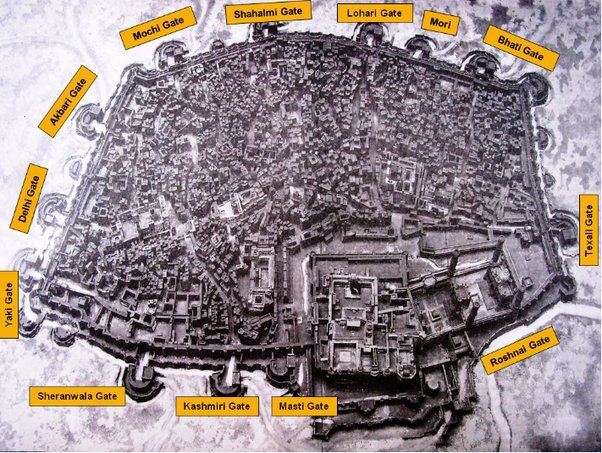
More Visits to Lahore
As a college student I visited LAHORE many a time to see historical places and buildings. I had been elected as the head of the ‘Tourist Association’ and in the company of some friends traveled a few times on cycle from FEROZEPORE to LAHORE, a distance of about 45 miles. The historical places of KASUR had already been visited by me.
LAHORE Fort was seen most keenly and thoroughly; it was built by Emperor AKBAR on the site of an old citadel. JAHANGIR, SHAH JEHAN and AURANGZEB had added some buildings in the fort, even the Sikhs had built a couple of buildings in their architecture style. To the north of HAZURI BAGH (between the BADSHAHI mosque and LAHORE fort) is situated the ROSHNAI DARWAZA or the Gate of Splendor. The fort and the palace extend from east to west for over 500 feet. The fort looks very majestic and it is said the river RAVI used to flow close to the wall of the fort.
About three miles north of LAHORE across the Ravi is situated SHAHDARA town. The mausoleum of Emperor JAHANGIR is located away from the bank of the Ravi and is a monument of surpassing beauty, the finest ornament of LAHORE and the most magnificent edifice in the sub continent after the TAJ MAHAL. I climbed the stairs of the minaret and on the south-west could see only three minarets of the BADSHAHI mosque, one being hidden behind the front one. JAHANGIR, on his death in KASHMIR in 1627 had expressed the wish to be buried in the garden of his beautiful and accomplished wife NUR JAHAN at Lahore called DILKUSHA, thus paying her the last tribute of love. The superb edifice was raised to his memory by his son SHAH JAHAN and supervised by NUR JAHAN. The building suffered much at the cruel hands of LAHNA SINGH and by his ruthless vandalism of RANJIT SING who stripped it of most of its choicest ornaments to decorate the Sikh temple of AMRITSAR.
The SERAE of JAHANGIR is situated to the west of the mausoleum. It has two gateways both richly decorated with marble and red sandstone.
Opposite the tomb of JAHANGIR, on a piece of ground, enclosed by high walls is the tomb of ASIF JAH, the brother of NUR JAHAN and a trusted minister of the Emperor. The building was in a deplorable condition and on top I saw vultures sitting and the area around looked deserted and haunted. RANJIT SINGH had removed most of its marble and costly stones to decorate the temple at AMRITSAR and also used it partly in building the marble summer house in the HAZURI BAGH. ASIF JAH was the father of ARJUMAND BANO, queen of SHAH JAHAN.
Close to the tomb of JAHANGIR is the tomb of NUR JAHAN, the consort of the Emperor. In her lifetime she had build the tomb. The marble sarcophagus (the over of the grave) was of most chaste workmanship with the names of God in the various significations engraved on it. It, alongwith other precious stones and marble slabs, was removed by RANJIT SINGH and historians have recorded that half the splendour of the temple of AMRITSAR is due to the marbles plundered from this mausoleum. When I visited this tomb it was in a deplorable condition, it looked totally deserted and haunted and only a few date trees provided some shade. It is mentioned in history that the inner room had two tombs – one of NUR JAHAN and the other of LADLI BEGUM, her daughter. When RANJIT SINGH stripped the building of its costly stones, he had the barbarity to cause the sealed rooms to be opened. Two coffins suspended on iron swings which were ruthlessly taken away and the coffins buried under ground. The cell was left open to be desecrated by wild beasts.
A few miles north east of LAHORE is situated the renowned and delightful garden of SHAH JAHAN, called SHALIMAR, meaning ‘House of Joy’. It is a magnificent remnant of MUGHAL grandeur. The garden is surrounded by a high brick wall, about 1100 yards in length and about 750 yards in breadth. It has three successive terraces, raised one above the level of the other by a height of 12 or 15 feet. The garden covers 80 acres of land. A canal brought water from a great distance and falls in the middle terrace into a large size marble basin and from there rose 450 fountains which threw water subsequently received into marble tanks. On the upper terrace there stands a beautiful marble BARADARI from where scene of waterfall and fountains gushing water can be seen. The pavilions and other buildings are found in various places, most of which are of marble and red stone. The garden was constructed in the 6th year of SHAH JAHAN’s rule in 1634 (1047 AH). It was completed under the supervision of ALI MARDAN KHAN and MULLA ALAULMULK on one year, five months and four days. It is a great feat of engineering. The Sikhs had laid their ruthless hands and stolen much of its decorative works. A costly pavilion of a gate was removed by LAHNA SINGH and sold for Rs. 24000 to stone polishers of LAHORE. RANJIT SINGH barbarously defaced the garden by removing a large portion of marble slabs to decorate his new construction of AMRITSAR temple.
I had occasion to enjoy many picnic parties in the garden and on holidays hundreds of people would visit the garden bringing their food and enjoying the shad of many thousand tress scattered all over the garden. In winter they would search for sunny spots. SHALIMAR garden is decidedly strikingly graphic and continues to attract people who visit it and enjoy its surroundings; the credit for all this goes to Emperor SHAH JAHAN.
I also saw the grave of QUTAB-UD-DIN AIBEK, the first Muslim King of INDIA. It was situated in those days on a platform of a house inside ANARKALI. Now a beautiful tomb has been built over his grave.
I visited to tomb of ANARKALI (the pomegranate blossom) located in one of the buildings of the Punjab Secretariat. The title was given to NADIRA BEGUM, a favourite of the harem by Emperor AKBAR. One day while the Emperor was seated in an apartment lined with looking glasses, with the beautiful ANARKALI attending him. The Emperor saw from her reflection in the mirror that she returned Prince SALIM (afterwards JAHANGIR) a smile. Suspecting that the two were in love the Emperor became furious and ordered her to be buried alive in an upright position at the appointed place. The love story of ANARKALI has been correctly highlighted in the great movie, MUGHAL-E-AZAM. SALIM felt intense remorse at her death and on succeeding AKBAR he built a tomb over her burial place. The sarcophagus is made of a block of pure marble of extraordinary beauty. On the top are inscribed the 99 names of Allah and on the sides is engraved the following Persian couplet composed by JAHANGIR. “Ah! I could behold the face of my beloved once more, I would give thanks unto my God until the day of restruction..”
LAHORE is full of historical places (tombs, mosques, temples, gardens, tombs of saints, etc) which I had seen. There are at least 50 old mosques but I could visit only a few dozen, including the magnificent NASJID-E-WAZIR KHAN. I offered Fateha on the shrines of DATA GANJ BAKHSH, MADHO LAL HUSSAIN, SHAH JAMAL, SHAH CHERAGH, SHAH MOHAMMAD GHS, MAJDARIA BUKHARI, ABDUL SHAK MA’ALI, MIAN MIR ALLAMA IQBAL and many others.
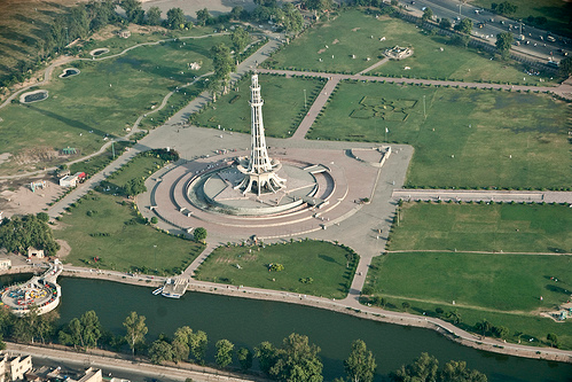
Conclusion
LAHORE is the ‘Heart of Pakistan’ and is most famous for its ancient monuments and splendid architecture. It possesses many historical sites such as tombs, palaces, havelis, gardens, mosques, gilded minarets, white marble domes, mandirs, over a dozen tombs of saints and the gigantic fort. LAHORE is also proud of the elegant and loft MINAR E PAKISTAN built on the site where the Lahore Resolution was passed on 23 March 1940 under the dynamic leadership of QUAID-E-AZAM for the demand of PAKISTAN. LAHORE is also called the city of colleges, famous as the centre of many newspapers and magazines in Urdu and English. Wrestling bouts are held frequently and JASHNE BAHARAN is avidly celebrated.
The dishes prepared in Lahore are also famous for variety and taste and are lustfully enjoyed. Particularly the breakfast (NEHARI) is famous all over for its richness and unique taste. Over a dozen fairs are celebrated through the year and are attended by thousands of people. In the end it would be appropriate to quote the famous proverb i.e. “You are not born if you have not seen LAHORE.”
Bibliography
1Lahore – Its history Architectural Remains and Antiquities:
Syed Muhammad Latif
2The History of Sikhs – Kushwant Singh
3The Sikh War – Amardal Sidhu
4Return of a King – William Dalrymple
5Many other books and my memory


